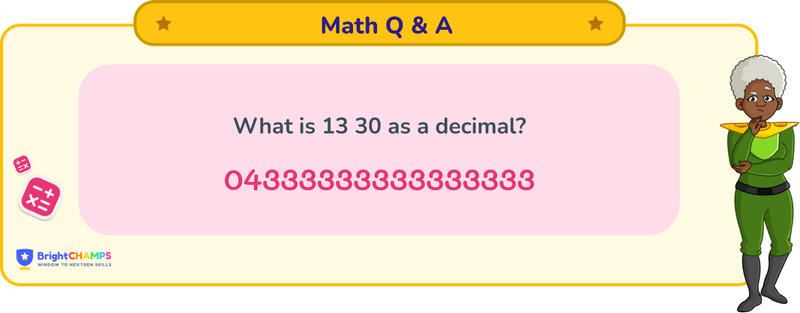
 149 Learners
149 LearnersLast updated on May 26th, 2025

13/30 as a Decimal

This is a straightforward question about converting fractions to decimals. To tackle this, we need to understand fractions and decimals. A fraction represents a part of a whole and consists of two parts: the numerator (the number on top) and the denominator (the number below). In the fraction 13/30, 13 is the numerator, showing how many parts we have, and 30 is the denominator, indicating how many parts make up the whole. A decimal represents a number that is not whole, using a decimal point (.) to separate the whole part from the fractional part. The numbers to the left of the decimal point are whole numbers, while those to the right are fractional.
What is 13/30 as a decimal?

Answer
13/30 as a decimal can be written as approximately 0.4333.
Explanation
To convert 13/30 to a decimal, we use division. Since 13 is smaller than 30, using decimal division will help us. Here is a step-by-step breakdown of the process:
Step 1: Identify the numerator and denominator. The numerator (13) will be the dividend, and the denominator (30) will be the divisor.
Step 2: As 13 is smaller than 30, direct division results in a quotient less than 1. Therefore, we'll use decimal division.
Step 3: Divide 13 by 30. Since 13 is less than 30, consider it as 130 by adding a decimal and a zero, and place a decimal point in the quotient.
Step 4: Now, divide 130 by 30. 30 goes into 130 four times (30 × 4 = 120).
Step 5: Subtract 120 from 130, which leaves 10. Bring down another 0 to make it 100.
Step 6: 30 goes into 100 three times (30 × 3 = 90). Subtract to get 10 again, and bring down another 0.
Step 7: The process repeats, showing a repeating decimal pattern of 0.4333...
Struggling with Math?
Get 1:1 Coaching to Boost Grades Fast !

Important Glossaries for 13/30 as a decimal
- Fraction: A numerical expression representing a part of a whole, consisting of a numerator and a denominator.
- Decimal: A numerical representation using the base ten, separating the whole part from the fractional part with a decimal point.
- Numerator: The top number in a fraction, indicating how many parts of the whole are considered.
- Denominator: The bottom number in a fraction, showing how many equal parts make up the whole.
- Recurring Decimal: A decimal with a repeating pattern of digits after the decimal point.




